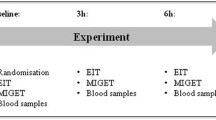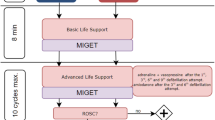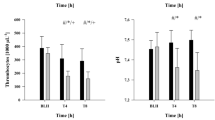Abstract
Background
Existing porcine models of endotoxic shock poorly represent the human situation.
Aims
To assess whether the cardiovascular profile of a porcine model could be improved by refining the protocol.
Methods
In 30 pigs, right and left heart pressures and cardiac output were measured. Lipopolysaccharide (LPS) was administered as a bolus (n=12), as a 30 minute infusion (n=6) or as a 30 minute infusion along with inhaled NO and volume resuscitation (n=6) and six sham-treated pigs received normal saline. Haemodynamic values were measured over three hours.
Results
LPS increased pulmonary vascular resistance (PVR) (13.3±1.4 to 37.0±3.9kPa/l per sec, p< 0.05) and reduced cardiac output (6.0±0.6 to 4.8±0.4l/min). Mortality was 50% within 30 minutes. Inhaled NO and volume resuscitation controlled pulmonary vascular resistance (PVR) and preserved CO. Systemic vascular resistance (SVR) declined in the first hour (118.4±11.8 to 65.8±8.2kPa/l per sec, p< 0.05) and remained low.
Conclusions
Porcine models of endotoxaemia based on LPS administration are a poor model of human septic shock, but can be improved by regulating PVR and supporting CO which may contribute to future studies of septic shock
Similar content being viewed by others

References
Parrillo JE, Parker MM, Natanson C et al. Septic shock in humans. Advances in the understanding of pathogenesis, cardiovascular dysfunction, and therapy.Ann Intern Med 1990; 113:227–42.
Goldfarb RD, Nightingale LM, Kish P et al. Left ventricular function during lethal and sublethal endotoxemia in swine.Am J Physiol 1986; 251: H364–73.
Schneider AJ, Teule GJJ, Kester ADM et al. Biventricular function during volume loading in porcine E. coli septic shock, with emphasis on right ventricular function.Circ Shock 1986; 18: 53–63.
Breslow MJ, Miller CF, Parker SD et al. Effect of vasopressors on organ blood flow during endotoxin shock in pigs.Am J Physiol 1987; 252: H291–300.
Naess F, Roeise O, Pillgram-Larsen J et al. Plasma kallikrein generation in endotoxemia is abolished by ultra high doses of methyl-prednisolone: in vivo studies in a pig model.Circ Shock 1991; 34: 349–55.
Fink MP, Kruithoff KL, Antonsson JB et al. Delayed treatment with an LTD4/E4 antagonist limits pulmonary edema in endotoxic pigs.Am J Physiol 1991; 260: R1007-R1013.
Olson NC, Kruse-Elliott KT, Dodam JR. Systemic and pulmonary reactions in swine with endotoxemia and Gram-negative bacteremia.J Am Vet Med Assoc 1992; 200: 1870–84.
Weitzberg E, Rudehill A, Lundberg JM. Nitric oxide inhalation attenuates pulmonary hypertension and improves gas exchange in endotoxin shock.Eur J Pharmacol 1993; 233; 85–94.
Berger JI, Gibson RL, Redding GJ et al. Effect of inhaled nitric oxide during group B streptococcal sepsis in piglets.Am Rev Respir Dis 1993; 147: 1080–86.
Li J-X, Oliver JR, Lu C-Y et al. Age-related differences in responses to endotoxin infusion in unanesthetised piglets.Circ Shock 1993; 41: 40–47.
Shoemaker WC, Appel PL, Kram HB et al. Temporal haemodynamic and oxygen transport patterns in medical patients.Chest 1993; 104: 1529–36.
Suffredini AF, Fromm RE, Parker MM et al. The cardiovascular response of normal humans to the administration of endotoxin.New Engl J Med 1989; 321: 280–7.
Robertson FM, Offner PJ, Ciceri DP et al. Detrimental haemodynamic effects of nitric oxide synthase inhibition in septic shock.Arch Surg 1994; 129: 149–156.
Weitzberg E, Rudehill A, Modin A et al. Effect of combined nitric oxide inhalation and NG-nitro-L-arginine infusion in porcine endotoxin shock.Crit Care Med 1995; 23: 909–18.
Kilbourn R, Billiar TR. Animal models of sepsis. In: Methods in Nitric Oxide Research. Eds. M Feelsich, JS Stamler. Wiley, Chichester 1996; pp 619–630.
Booke M, Hinder F, Traber LD et al. Effects of L-arginine and L-nitro-arginine treatment on blood pressure and cardiac output in a rabbit endotoxin shock model (letter).Crit Care Med 1995; 23: 782.
Herity NA, Allen JD, Silke B et al. Comparison of the ability of nicardipine, theophylline and zaprinast to restore cardiovascular haemodynamics following inhibition of nitric oxide synthesis.Br J Pharmacol 1994; 112: 423–8.
Lundberg J, Ahlborg G, Hemsen A et al. Evidence for release of endothelin-1 in pigs and humans.J Cardiovasc Pharmacol 1991; 17 Suppl 7: S350–3.
Cremona G, Wood AM, Hall LW et al. Effect of inhibitors of nitric oxide release and action on vascular tone in isolated lungs of pig, sheep, dog and man.J Physiol 1994; 481: 185–95.
Frostell C, Fratacci M-D, Wain JC et al. Inhaled nitric oxide. A selective pulmonary vasodilator reversing hypoxic pulmonary vasoconstriction.Circulation 1991; 83: 2038–47.
Rossaint R, Falke KJ, Lopez F et al. Inhaled nitric oxide for the adult respiratory distress syndrome.New Engt J Med 1993; 328: 399–405.
Author information
Authors and Affiliations
Corresponding author
Rights and permissions
About this article
Cite this article
Herity, N.A., Allen, J.D., Silke, B. et al. Inhaled nitric oxide in combination with volume resuscitation refines a porcine model of endotoxic shock. Ir J Med Sci 170, 172–175 (2001). https://doi.org/10.1007/BF03173883
Issue Date:
DOI: https://doi.org/10.1007/BF03173883



